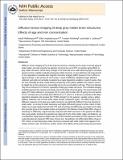| dc.contributor.author | Pfefferbaum, Adolf | |
| dc.contributor.author | Adalsteinsson, Elfar | |
| dc.contributor.author | Rohlfing, Torsten | |
| dc.contributor.author | Sullivan, Edith V. | |
| dc.date.accessioned | 2015-11-04T14:17:54Z | |
| dc.date.available | 2015-11-04T14:17:54Z | |
| dc.date.issued | 2008-05 | |
| dc.date.submitted | 2008-04 | |
| dc.identifier.issn | 01974580 | |
| dc.identifier.uri | http://hdl.handle.net/1721.1/99705 | |
| dc.description.abstract | Diffusion tensor imaging (DTI) of the brain has become a mainstay in the study of normal aging of white matter, and only recently has attention turned to the use of DTI to examine aging effects in gray matter structures. Of the many changes in the brain that occur with advancing age is increased presence of iron, notable in selective deep gray matter structures. In vivo detection and measurement of iron deposition is possible with magnetic resonance imaging (MRI) because of iron's effect on signal intensity. In the process of a DTI study, a series of diffusion-weighted images (DWI) is collected, and while not normally considered as a major dependent variable in research studies, they are used clinically and they reveal striking conspicuity of the globus pallidus and putamen caused by signal loss in these structures, presumably due to iron accumulation with age. These iron deposits may in turn influence DTI metrics, especially of deep gray matter structures. The combined imaging modality approach has not been previously used in the study of normal aging. The present study used legacy DTI data collected in 10 younger (22–37 years) and 10 older (65–79 years) men and women at 3.0 T and fast spin-echo (FSE) data collected at 1.5 T and 3.0 T to derive an estimate of the field-dependent relaxation rate increase (the “FDRI estimate”) in the putamen, caudate nucleus, globus pallidus, thalamus, and a frontal white matter sample comparison region. The effect of age on the diffusion measures in the deep gray matter structures was distinctly different from that reported in white matter. In contrast to lower anisotropy and higher diffusivity typical in white matter of older relative to younger adults observed with DTI, both anisotropy and diffusivity were higher in the older than younger group in the caudate nucleus and putamen; the thalamus showed little effect of age on anisotropy or diffusivity. Signal intensity measured with DWI was lower in the putamen of elderly than young adults, whereas the opposite was observed for the white matter region and thalamus. As a retrospective study based on legacy data, the FDRI estimates were based on FSE sequences, which underestimated the classical FDRI index of brain iron. Nonetheless, the differential effects of age on DTI metrics in subcortical gray matter structures compared with white matter tracts appears to be related, at least in part, to local iron content, which in the elderly of the present study was prominent in the FDRI estimate of the putamen and visibly striking in the diffusion-weighted image of the basal ganglia structures. | en_US |
| dc.description.sponsorship | National Institutes of Health (U.S.) (Grant AG17919) | en_US |
| dc.description.sponsorship | National Institutes of Health (U.S.) (Grant AA05965) | en_US |
| dc.description.sponsorship | National Institutes of Health (U.S.) (Grant AA10723) | en_US |
| dc.description.sponsorship | National Institutes of Health (U.S.) (Grant AA12388) | en_US |
| dc.language.iso | en_US | |
| dc.publisher | Elsevier | en_US |
| dc.relation.isversionof | http://dx.doi.org/10.1016/j.neurobiolaging.2008.04.013 | en_US |
| dc.rights | Creative Commons Attribution | en_US |
| dc.rights.uri | http://creativecommons.org/licenses/by-nc-nd/4.0/ | en_US |
| dc.source | PMC | en_US |
| dc.title | Diffusion tensor imaging of deep gray matter brain structures: Effects of age and iron concentration | en_US |
| dc.type | Article | en_US |
| dc.identifier.citation | Pfefferbaum, Adolf, Elfar Adalsteinsson, Torsten Rohlfing, and Edith V. Sullivan. “Diffusion Tensor Imaging of Deep Gray Matter Brain Structures: Effects of Age and Iron Concentration.” Neurobiology of Aging 31, no. 3 (March 2010): 482–493. | en_US |
| dc.contributor.department | Harvard University--MIT Division of Health Sciences and Technology | en_US |
| dc.contributor.department | Massachusetts Institute of Technology. Department of Electrical Engineering and Computer Science | en_US |
| dc.contributor.mitauthor | Adalsteinsson, Elfar | en_US |
| dc.relation.journal | Neurobiology of Aging | en_US |
| dc.eprint.version | Author's final manuscript | en_US |
| dc.type.uri | http://purl.org/eprint/type/JournalArticle | en_US |
| eprint.status | http://purl.org/eprint/status/PeerReviewed | en_US |
| dspace.orderedauthors | Pfefferbaum, Adolf; Adalsteinsson, Elfar; Rohlfing, Torsten; Sullivan, Edith V. | en_US |
| dc.identifier.orcid | https://orcid.org/0000-0002-7637-2914 | |
| mit.license | PUBLISHER_CC | en_US |
| mit.metadata.status | Complete | |
